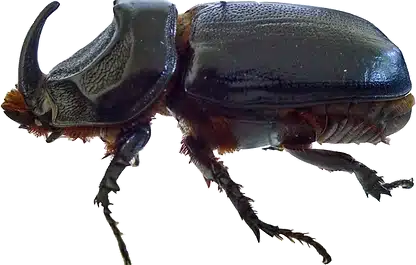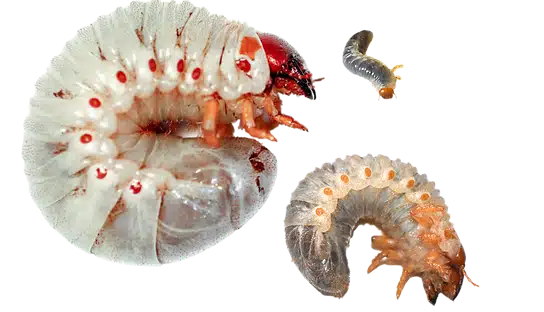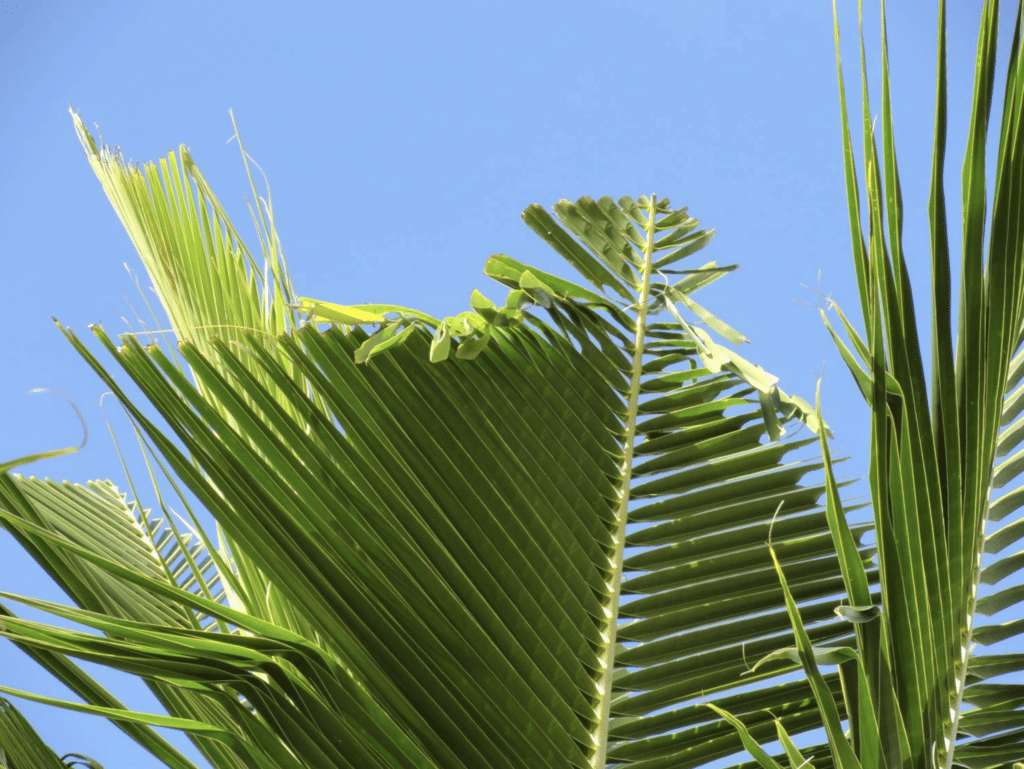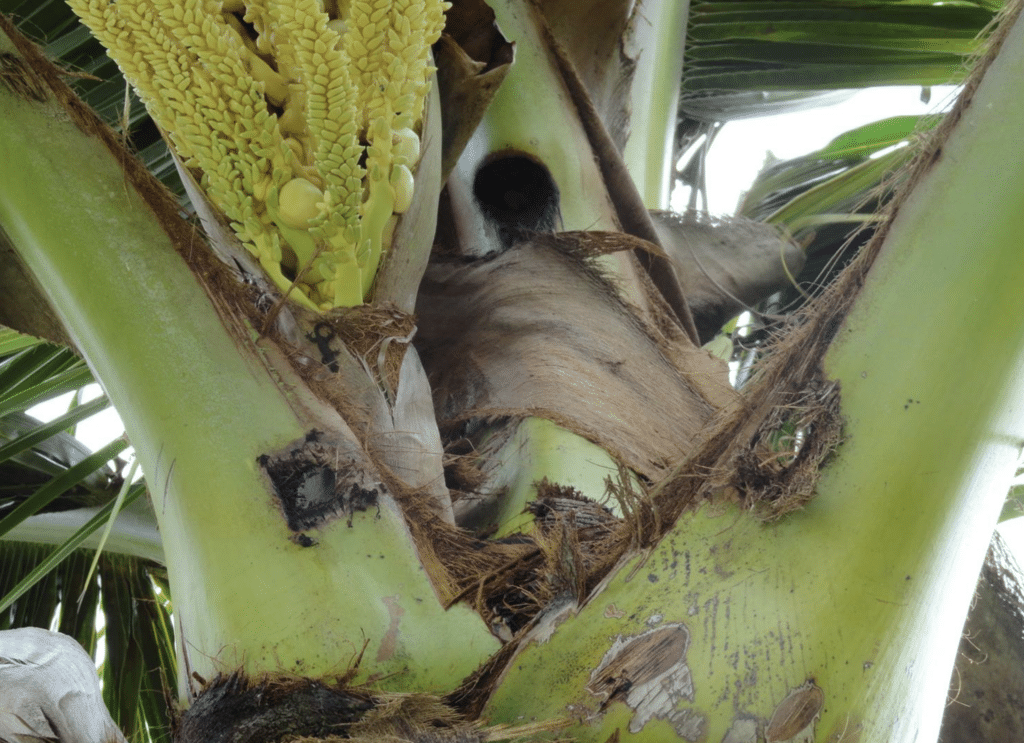The Coconut Rhinoceros Beetle (CRB), scientifically known as Oryctes rhinoceros, has emerged as a formidable pest in tropical regions, particularly in Oahu, Hawaii. This invasive species targets palm trees, a key component of the local landscape and economy. Palms not only enhance the natural beauty of the island but also play a crucial role in the tourism industry and provide critical agricultural resources.
CRB adults are easily identifiable by their sizeable, robust bodies, measuring up to two inches in length, and a single, distinctive horn on their heads, reminiscent of a rhinoceros. The damage caused by these beetles can be catastrophic; they bore into the crowns of palm trees to feed on their sap, thereby stunting their growth and, in severe cases, killing them. The presence of these pests poses a significant threat to the ecological health and aesthetic value of Oahu’s palm populations.
Origin and Global Spread of the Coconut Rhinoceros Beetle
Originally native to Southeast Asia, the Coconut Rhinoceros Beetle has spread to various parts of the Asia-Pacific region, including the Pacific Islands. It was first detected in Oahu in December 2013 and has since become a major concern for agricultural and environmental authorities. The beetle’s introduction to the island is believed to have been through human activities, possibly via cargo ships that inadvertently transported infested materials.
CRB’s adaptability to various climates has facilitated its spread across borders, affecting not only natural palm forests but also commercial and residential areas where palms are prevalent. Its impact extends beyond mere physical damage to trees; it disrupts local ecosystems and affects the livelihoods of those dependent on palm products. As it continues to invade new territories, the importance of understanding and controlling its spread becomes increasingly critical.
The Life Cycle and Identification of the Coconut Rhinoceros Beetle
Understanding the life cycle of the Coconut Rhinoceros Beetle (CRB) is key to effectively identifying and managing this invasive pest. The CRB’s life cycle consists of four main stages: egg, larva, pupa, and adult. Each stage requires specific conditions, which influence the beetle’s development and activity.

Identifying Adult Beetles
Adult Coconut Rhinoceros Beetle can reach lengths of up to two inches and have a robust, dark brown to black body covered with a hard, shiny shell. Their most distinctive feature is a horn on their head, giving them the “rhinoceros” nickname. These beetles are nocturnal, often feeding at night and hiding during the day. They bore into the crown of palm trees to feed on the sap of emerging fronds. The damage caused by this feeding can lead to distinctive V-shaped cuts on palm leaves or holes in the crown. Identifying these visual symptoms is one of the first signs of Coconut Rhinoceros Beetle presence.
Another method of detection is through pheromone traps that attract adult beetles. These traps contain lures designed to draw beetles in from surrounding areas, aiding in monitoring CRB populations. Monitoring traps can be an effective way of assessing the presence of beetles before they cause significant damage.

Identifying Larvae
Coconut Rhinoceros Beetle larvae are large, cream-colored grubs that can grow up to four inches long. Their distinctive C-shaped bodies have three pairs of legs near the head and a dark head capsule. Larvae typically reside in decomposing organic matter like compost piles, mulch, and rotting tree stumps, where they feed until reaching the pupal stage. They can be distinguished from other larvae by their large size and their preference for decaying plant material.
To confirm Coconut Rhinoceros Beetle larvae, look for their distinctive undersides, which have a pattern of fine bristles that help them move through the soil. Observing them crawling in this C-shape can further distinguish them from other grub species. If larvae are found in a suspected breeding site, it is essential to report the location to authorities immediately to prevent further spread and initiate appropriate control measures.
Signs of a CRB Infestation
Identifying a Coconut Rhinoceros Beetle infestation requires vigilance and a keen eye for the subtle yet distinctive signs of their presence. Here are some common indicators:

Visible V-Cuts and Bore Holes in Palm Fronds and Crowns
One of the clearest signs of a Coconut Rhinoceros Beetle infestation is the distinctive V-cuts and boreholes in palm fronds and crowns. Adult beetles bore into the crown of palm trees to feed on the emerging fronds, which leave V-shaped notches on the fronds and large bore holes in the crown. This damage can lead to a significant reduction in the tree’s aesthetic and commercial value. Spotting these cuts early is crucial, as they signal that beetles are actively feeding and damaging your palms.
Presence of Larvae in Mulch Piles or Compost
CRB larvae thrive in decomposing organic matter, such as mulch piles, compost, and rotting tree stumps. Finding these large, C-shaped, cream-colored grubs in such material is a strong indication of an active breeding site. Regularly inspecting mulch piles, compost, and other organic waste around your property can help detect and eliminate breeding grounds before the beetles reach adulthood.
Dieback and Loss of Emerging Fronds
As CRB adults feed on the crowns of palm trees, they weaken and destroy the central growing point, leading to the dieback of the fronds and an overall decline in the tree’s health. The loss of emerging fronds significantly affects the palm’s growth, causing it to appear thin and unhealthy. If your palm trees are losing new growth or show signs of decline, it is essential to inspect the crowns for beetle activity.
General Decline of Palm Health
A general decline in the health of your palms, such as discoloration, stunted growth, or a sparse canopy, could also indicate a CRB infestation. When beetles damage the crown of the tree, it compromises the palm’s ability to regenerate and thrive. This decline can make the tree more susceptible to other pests and diseases, further worsening its condition.
Early detection of these signs can make a significant difference in managing and controlling the spread of Coconut Rhinoceros Beetles. If you notice any of these symptoms, it is essential to contact an expert for an assessment and consider preventative measures like regular inspections or treatments. Mana Home Services is ready to assist with free estimates and comprehensive management plans tailored to your property’s needs.
Impact of a CRB Infestation
Coconut Rhinoceros Beetle infestations can have far-reaching consequences for ecosystems, agriculture, and homeowners. Understanding these impacts underscores the importance of prompt detection and effective management strategies.
Damage to Local Ecosystems, Agriculture, and Cultural Heritage
The most immediate and visible impact of CRB infestations is the devastation they cause to palm trees, which are not only vital to the ecosystem but also integral to cultural and economic life in Oahu and throughout Hawaii. As CRB adults bore into palm crowns to feed, they impair the tree’s ability to produce healthy fronds, eventually leading to death if left untreated. This damage disrupts the delicate balance of local ecosystems, depriving native bird and insect species of their natural habitats.
Culturally, palms like the coconut and date palms are significant symbols of Hawaii’s heritage. They provide essential materials for traditional crafts, rituals, and celebrations, which are at risk of being lost due to infestations. Additionally, palms are crucial to the state’s agricultural industry, which relies heavily on coconuts, dates, and other palm products. Infestations can severely impact crop yields, leading to financial losses for farmers and diminishing the state’s economic vitality.
Financial Implications for Affected Property Owners
For individual property owners, the effects of a CRB infestation are both costly and distressing. Removing and replacing damaged palms can be an expensive endeavor, and the presence of beetles may necessitate the implementation of control measures like chemical treatments or intensive green waste management. If untreated, infestations can also affect the aesthetic appeal and property value of homes, further compounding financial losses.
Moreover, managing an infestation requires vigilance and time, diverting attention and resources away from other pressing matters. The financial burden can be alleviated by early detection and proactive management plans. Mana Home Services offers free estimates and tailored treatment solutions, ensuring that property owners are equipped with the knowledge and resources to safeguard their investments and maintain the beauty and health of their landscapes.
Preventing the Spread of Coconut Rhinoceros Beetles
Preventing the spread of Coconut Rhinoceros Beetle infestations requires proactive strategies focused on interrupting their breeding cycles and minimizing the movement of infested materials. Here are some key prevention methods that property owners can employ:
Proper Green Waste Management
Effective green waste management is crucial in controlling Coconut Rhinoceros Beetle populations. Since beetles and their larvae breed in decomposing plant materials like mulch, compost, and stumps, handling these waste products properly is essential.
- Secure Disposal: Use secure bins for disposing of plant waste to prevent beetles from accessing breeding materials. Bins with tight-fitting lids or sealed containers will limit exposure and opportunities for CRB.
- Treatment Facilities: Send green waste to treatment facilities that are specifically designed to handle and process this material. Oahu’s City and County green waste bins, Hawaiian Earth Products, and Island Topsoil are ideal options. They treat plant waste thoroughly, reducing the chances of breeding.
Avoiding the Transport of Breeding Materials
Moving potentially infested material from one place to another is one of the main ways CRB infestations can spread.
- Mulch and Compost: Avoid transporting mulch or compost to other regions or islands where CRB may not yet be established. Be sure to inspect mulch or compost carefully before use and avoid spreading it in areas where beetles could establish new populations.
- Inspections: Regularly inspect bags of mulch and compost for any signs of beetle activity before bringing them home. Look for holes or other indicators of insect presence and avoid purchasing compromised products.
Inspecting and Treating Palms
Regular inspection of palm trees is a critical step in detecting and stopping an infestation before it escalates.
- Check for Signs of Infestation: Inspect the base and crown of your palms regularly for V-cuts, boreholes, and dieback. Look closely for fronds that appear to be chewed or damaged.
- Treat Infested Trees: If signs of CRB activity are identified, consider using systemic pesticides like imidacloprid or acephate. These treatments target beetles directly and reduce their ability to damage palms further.
Mana Home Services can help you establish a comprehensive plan to inspect your property and apply appropriate treatments, ensuring your landscape is effectively safeguarded against the spread of CRB.
Solutions and Professional Help
When it comes to managing Coconut Rhinoceros Beetle (CRB) infestations, prompt identification and immediate action can make all the difference. Here’s how early detection, professional inspection, and specialized treatment solutions can help safeguard your property and local environment.
Importance of Early Detection and Immediate Action
Detecting CRB infestations early is crucial to limiting their impact on palm trees, ecosystems, and property values. Left unchecked, beetles can multiply rapidly and spread to neighboring areas.
- Early Detection: Monitoring palms for signs of Coconut Rhinoceros Beetle presence, like V-cuts, boreholes, and frond dieback, is essential. Quick identification allows for faster treatment, reducing damage to trees and preventing the beetles from laying eggs in new breeding grounds.
- Immediate Action: Once a Coconut Rhinoceros Beetle infestation is confirmed, swift action is required. By eliminating breeding sites and treating infested trees quickly, homeowners can minimize further damage and avoid long-term health issues for their palm trees.
How Mana Home Services Can Help
Mana Home Services is dedicated to providing expert assistance in identifying and treating CRB infestations. Our comprehensive services include:
- Inspection and Free Estimates: Our team offers free, no-obligation inspections to assess potential infestations and provide tailored solutions based on the severity of the situation.
- Tailored Treatment Solutions: We develop individualized treatment plans to meet your specific needs. These can include systemic pesticide applications, netting crowns of shorter palms, or removing and treating breeding materials to eliminate CRB populations at their source.
With a dedicated and experienced team, Mana Home Services is committed to protecting your property and community. Contact us today for a free inspection and tailored treatment solution.
Contact Us
Mana Home Services is your trusted partner in fighting Coconut Rhinoceros Beetle infestations and ensuring the health of your palm trees. Our expert team is ready to provide you with a comprehensive inspection, free estimate, and tailored solutions to protect your trees and property.
Reach out to us today:
- Phone: Call us at 808-213-0249 to speak directly with our team. We’ll schedule a convenient time for a complimentary inspection and estimate.
- Online Form: Contact us here to fill out a simple online form, and we’ll follow up to arrange a professional inspection.
By scheduling an inspection with us, you’re taking the first step towards safeguarding your palm trees and maintaining the value of your property. Our experts will work with you to find a solution that meets your unique needs. Don’t wait for the infestation to worsen—contact Mana Home Services today for peace of mind and reliable assistance.
Frequently Asked Questions
Where Have Coconut Rhinoceros Beetles Been Found in Hawaiʻi?
Coconut Rhinoceros Beetles (CRB) are widespread on Oʻahu and were first identified on Kauai in May 2023, followed by Hawaii Island in October 2023, and Maui in November 2023. You can check our website for the latest heat maps to see their current distribution.
Are There Pesticides That Work Against Coconut Rhinoceros Beetle?
Pesticides are available as foliar sprays, root drenches, or systemic injections. Although the damage won’t stop entirely, these pesticides will reduce it when there’s a decrease in the local CRB population.
How Did Coconut Rhinoceros Beetles Reach Hawaiʻi?
Although the exact invasion path remains unclear, genetic and pathway analyses point to human-mediated movement from another Pacific Island. On Oʻahu, the first sightings were recorded near the airport at Mamala Bay.
How Far Can Adult Coconut Rhinoceros BeetleFly?
Research shows adult beetles can fly up to two miles per day. However, since flying uses a lot of energy, they usually stay close to abundant food and breeding sources.
Did the Military Bring Coconut Rhinoceros Beetleto Hawaiʻi?
Both commercial and military flights arrive from regions with CRB populations, so it’s not possible to determine if the military specifically introduced them.
What Should I Do if I Find an Adult Coconut Rhinoceros Beetle?
On Oʻahu: Collect the beetle in a glass or plastic container, then freeze it overnight. Once frozen, you can dispose of it. Beetles don’t need to be reported on Oʻahu, but it’s advisable to follow up with treatment and best management practices. If you need assistance please do not hesitate to reach out and contact us.
Neighboring Islands: Capture the beetle and place it in a jar or container. If no container is available, crush the beetle. Record where you found it, and immediately contact the CRB Response team at 808-679-5244 or via email at info@crbhawaii.org.
What if I Find a Coconut Rhinoceros Beetle Larva in a Purchased Compost Bag?
If larvae are discovered soon after purchase, secure the material in a container (like a 5-gallon bucket) and inform the store for a refund. Do not dump it in gardens, pots, or natural areas. If the infestation is found much later, ensure the larvae and adults are dead before disposing of the material.
Buying Tips:
- Inspect all compost bags for signs of Coconut Rhinoceros Beetle, and notify a store employee if you see any.
- Buy locally to prevent accidental spread to CRB-free areas.
- Store the bags in a secure container to prevent future infestation.
What Should I Do With My Plant Waste?
Treat or remove plant waste (mulch, trimmings, compost) to avoid creating new breeding grounds. On Oʻahu, dispose of waste through city bins or specific facilities. For neighboring islands, the CRB Response team can provide tailored recommendations.
Are Coconut Rhinoceros BeetleBeetles or Larvae Dangerous to Humans?
CRB doesn’t physically harm people, but it can affect agriculture and cultural resources. Since they live in dirt and mulch, they can carry bacteria, so it’s best to avoid handling them directly.
Is Research Being Conducted to Control Coconut Rhinoceros Beetle?
Yes, research is ongoing at the University of Hawai’i at Mānoa. They collaborate with national and international researchers to explore new control methods and refine existing practices.


